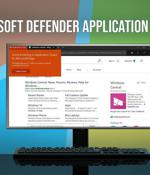Security News

By leveraging more than 20 known vulnerabilities in Linux and Windows servers, the HolesWarm cryptominer malware has been able to break into more than 1,000 cloud hosts just since June. The basic cryptominer botnet has been so successful at juggling so many different known vulnerabilities between attacks, researchers at Tencent who first identified HolesWarm refer to the malware as the "King of Vulnerability Exploitation."

Microsoft Defender Application Guard protects your networks and data from malicious applications running in your web browser. Learn how to install and activate this Windows 10 security feature.

If you can't find your favorite Windows Subsystem for Linux distribution available in the Microsoft Store, a new program called EasyWSL can convert almost any Linux Docker image into a WSL distro. The Microsoft Store offers many prebuilt Linux WSL distributions such as Fedora, Ubuntu, Alpine, Kali, Debian, and more.

Microsoft confirms another Windows Print Spooler bug, offers workaroundA day after the August 2021 Patch Tuesday, Microsoft has released an out-of-band security advisory acknowledging the existence of yet another Print Spooler vulnerability. World Health Organization CISO suggests a holistic approach to cybersecurityIn this interview with Help Net Security, Flavio Aggio, CISO at the World Health Organization, talks about the modern threat landscape and offers tips for organizations that want to increase their security posture.

A security researcher has figured out a way to dump a user's unencrypted plaintext Microsoft Azure credentials from Microsoft's new Windows 365 Cloud PC service using Mimikatz. On August 2nd, Microsoft launched their Windows 365 cloud-based desktop service, allowing users to rent Cloud PCs and access them via remote desktop clients or a browser.

A day after the August 2021 Patch Tuesday, Microsoft has released an out-of-band security advisory acknowledging the existence of yet another Print Spooler vulnerability. Microsoft says that CVE-2021-36958 is a remote code execution vulnerability exists when the Windows Print Spooler service improperly performs privileged file operations.

Ransomware operators such as Magniber and Vice Society are actively exploiting vulnerabilities in Windows Print Spooler to compromise victims and spread laterally across a victim's network to deploy file-encrypting payloads on targeted systems. "Multiple, distinct threat actors view this vulnerability as attractive to use during their attacks and may indicate that this vulnerability will continue to see more widespread adoption and incorporation by various adversaries moving forward," Cisco Talos said in a report published Thursday, corroborating an independent analysis from CrowdStrike, which observed instances of Magniber ransomware infections targeting entities in South Korea.

Ransomware operators such as Magniber and Vice Society are actively exploiting vulnerabilities in Windows Print Spooler to compromise victims and spread laterally across a victim's network to deploy file-encrypting payloads on targeted systems. "Multiple, distinct threat actors view this vulnerability as attractive to use during their attacks and may indicate that this vulnerability will continue to see more widespread adoption and incorporation by various adversaries moving forward," Cisco Talos said in a report published Thursday, corroborating an independent analysis from CrowdStrike, which observed instances of Magniber ransomware infections targeting entities in South Korea.

Microsoft is rolling out its first Windows 11 app updates with new versions of the Calculator, Mail and Calendar, and the Snipping Tool apps. "In Windows 11, both the classic Snipping Tool and Snip & Sketch apps have been replaced by a new Snipping Tool app that represents the best experiences of both apps in the next evolution of screen capture for Windows," announced Microsoft in a new blog post.

Ransomware operators have added PrintNightmare exploits to their arsenal and are targeting Windows servers to deploy Magniber ransomware payloads. PrintNightmare is a class of security vulnerabilities impacting the Windows Print Spooler service, Windows print drivers, and the Windows Point and Print feature.